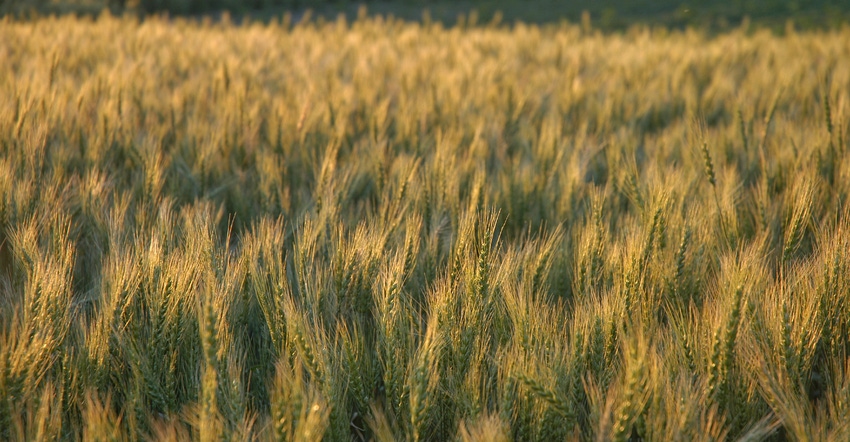
Winter wheat may be a good crop to consider planting this fall. It can provide an important green cover on fields that you couldn’t get planted this spring. It will also spread out fieldwork. Best of all, winter wheat frequently out-yields spring wheat.
Seven tips for successful winter wheat production from Joel Ransom, North Dakota State University Extension agronomist, and Ruth Beck, South Dakota State University Extension agronomist, are:
1. When possible plant winter wheat into standing stubble. Survival of winter wheat is enhanced when it is covered with snow during the coldest months of the year. Ensuring that the crown of the wheat is well-insulated is very important.
Standing crop residues can effectively retain snow, but residue on the soil surface as one would find in many no-till fields can also provide protection to winter wheat during the winter. Tall, erect flax and canola stubble works best, but any erect stubble that retains snow or surface residue is recommended.
Planting winter wheat into wheat stubble is not ideal for disease reasons, but as long as disease-insect management is planned, wheat stubble can be an acceptable residue.
2. Plant a winter hardy variety, especially if you are not planting into a standing residue. This recommendation would apply to prevent plant acres with limited standing stubble. Ratings for the winter hardiness of currently available varieties are summarized in the Winter Wheat Variety Selection Guide.
Additionally, the results of the 2018 winter wheat variety trials from many of the North Dakota Research and Education Centers are available online as well. Results from SDSU’s 2018-19 winter wheat variety trials will be available prior to 2019 planting. Be sure to check the SDSU Extension website. The information can help you select varieties that will likely perform well in your farm.
For availability of certified seed, refer to the seed guides in North Dakota and South Dakota.
3. In North Dakota, plant in September. The optimum planting date for the northern half of the state is Sept. 1-15 and for the southern half, Sept. 15-30. However, in recent years, plantings during the first 10 days of October for southern regions of the North Dakota have largely been successful.
Recommended planting dates for South Dakota are Sept. 10 through Oct. 10. Growers located in northern in South Dakota should consider planting in the earlier part of this date range. Planting too early is not recommended as it can increase issues with wheat streak mosaic virus and aphids that vector barley yellow dwarf virus.
The last practical date that winter wheat can be planted will depend on the weather, but there must be enough moisture and growing degree days so that the seed can germinate, and the seedling vernalize by spring. Larger seedlings will overwinter better than smaller ones. Target the earlier portion of the recommended planting date range if planting into bare, fallow ground. Planting too early in prevent plant acres may pre-dispose the crop to becoming infested with wheat streak mosaic virus.
4. Plant 1 to 1.5 inches deep. Adequate moisture for establishing winter wheat is often a concern as the soil profile is usually depleted of moisture in the fall. If there is little or no moisture in the soil’s surface, planting shallow (1 to 1.5 inches deep) and waiting for rain is recommended.
Furthermore, these relatively shallow planting depths allow for faster emergence when temperatures are rapidly decreasing.
5. Seed about a million seeds per acre. Generally, a seeding rate of 900,000 to 1.2 million viable seed per acre is adequate. The higher seeding rate may be appropriate if planting late or when planting into poor seedbeds. Since winter wheat tends to tiller more profusely than spring wheat, 1.2 million seeds per acre is the upper end of the recommended seeding rate.
Excessively high seeding rates can result in more lodging by harvest time, particularly if you are using a taller variety (like Jerry). South Dakota farmers who are aiming for higher yields typically use higher seeding rates and withhold nitrogen from the wheat until tillering is almost finished. This reduces lodging.
Excessive tillers can result in late small heads that can have lower test weight. The goal is for each plant to have one main head and 1-2 tillers.
6. Break the green bridge. Breaking the green bridge is critical to reducing the risk of infection of the wheat streak mosaic virus. This disease is vectored by a tiny mite that moves from green tissue to green tissue by wind. Breaking the green bridge is particularly important when winter wheat is planted early.
The green bridge is broken by controlling volunteer cereal crops and grassy weeds in a field, two weeks prior to planting winter wheat. A two-week window of not having a green host present assures that the mite has gone through its lifecycle and died before finding a host to feed on and transmit the virus.
Breaking the green bridge is still an important consideration in prevent plant acres if there are grassy weeds present prior to winter wheat planting.
7. Avoid planting varieties highly susceptible to scab. Scab is not always a problem in winter wheat. Nevertheless, check the recent selection guides for the level of scab resistance in currently available varieties. North Dakota varieties rated as the most resistant include Emerson, Lyman, Moats and Redfield.
About the Author(s)
You May Also Like






